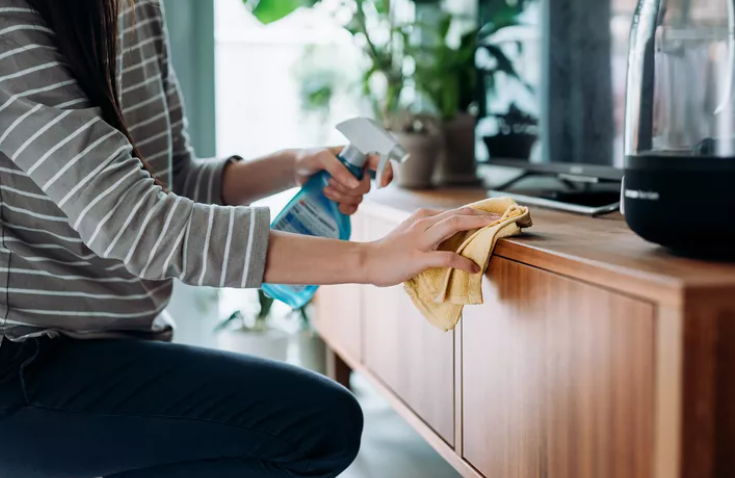Classic wood furniture never goes out of style and is often featured in farmhouse, vintage, and midcentury modern styles as family heirlooms and flea market finds. However, wood furniture can also be frustrating to clean. Over time, it tends to show dirt that can’t be removed with a duster. And sometimes, even if you try to clean it, shiny streaks are left behind.
When it comes to wood furniture maintenance, there are a number of terms that get tossed around, such as dusting, cleaning, waxing, and polishing. While experts have varying opinions on wood furniture care, the technique you use will depend on the finish.
What’s the best way to dust wood furniture? Learn how to clean grime off, plus find care tips to keep decades-old pieces looking new.

How to Dust Wood Furniture
To keep wood furniture in its best shape, dust frequently. Dust can cause airborne deposits that eventually build up in a filmy layer and scratch the surface of wood furniture. Leaving dust on your furniture can also decrease your indoor air quality, trigger allergies, or be harmful to those with asthma. Most dust lives in fabric, so try to minimize the dust sent into the air by regularly vacuuming carpets or upholstery as well.
What You Need
- Microfiber cloth
- Terrycloth towel
- Feather duster (optional)
Step 1: Use the Right Tool
When searching for a dusting tool for wood furniture, choose something that dust will cling to, rather than something that will pick it up only to spew it out into the air. Dry, soft cloths and feather dusters will effectively remove dust from wood furniture.
Step 2: Dust Furniture
To properly dust furniture, capture and remove dust as opposed to spreading it around the surface. To avoid scattering the dust into the air, where it’ll float until landing back on furniture surfaces, very lightly dampen a microfiber cloth before wiping down. Remove excess moisture with a dry terry towel.

How to Clean Wood Furniture
When cleaning wood furnishings, never use all-purpose cleaning sprays, such as the kind used on kitchen tables, unless your furniture has a plastic coating. If you’ve used wood sprays and polishes in the past or suspect that furniture has been polished with them, be aware that these residues can interfere with refinishing and may need professional attention.
What You Need
- Olive oil
- Denatured alcohol
- Gum turpentine
- Strained lemon juice
- Soft cloth
- Clean cloth
- Soap (optional)
- Water (optional)
- Lint-free cloth (optional)
Be careful when mixing household cleaners—store-bought or homemade—as fumes and gases can become toxic and lead to harmful secondary effects.
Step 1: Prepare the Cleaner
To revive grimy wood furniture, mix equal parts olive oil, denatured alcohol, gum turpentine, and strained lemon juice.
Step 2: Apply and Buff
Apply with a soft cloth and buff with a clean cloth.
Step 3: Remove Sticky Spots
Sticky spots may need to be treated with soap and water. To do this, dip a lint-free cloth in mild soap or detergent dissolved in water, wring the cloth nearly dry, and wipe the area. Rinse and immediately dry with a clean, soft cloth.

How to Apply Furniture Paste Wax
Typically during manufacture, varnish, polyurethane, or shellac is applied to wood to protect the surface. Applying wax or polish protects the manufacturer’s finish and helps to reduce surface scratches. Wax provides a hard finish and long-lasting protection, doesn’t smear, and is more durable than sprays or polishes.
Wax needs to be applied to furniture correctly, or it can cause streaks and a cloudy appearance. To properly apply furniture wax to restore shine in your wood furnishings, remember to always apply wax in light coats, rubbing into the surface with the grain.
What You Need
- Paste wax or liquid wax specifically for furniture
- 100% cotton fabric cloths
- Electric drill or power driller
- Lamb’s wool duster
Step 1: Prepare Wax
Put a spoonful of wood furniture wax, about the size of a golf ball, in a square of 100% cotton fabric. Wrap the fabric around the wax ball and knead it until soft.
Step 2: Wax and Wipe
Rub the wax-saturated fabric on the surface of the furniture, one small area at a time, until the surface dulls. Wipe off the excess wax with a clean, soft cotton cloth. Repeat waxing and wiping until the entire piece of wood furniture is waxed. If you notice a streak, keep wiping to remove excess wax.
Step 3: Polish and Buff
Polish wood furniture with a soft cloth or lamb’s-wool pad attached to an electric drill or power buffer. If the wax smears, wipe with a soft cloth and continue buffing.
Step 4: Repeat and Maintain
For a deep shine, apply a second coat of wax in the same manner. To maintain waxed furniture, dust with a lamb’s-wool duster. Never use liquid or aerosol furniture polishes because they can dissolve the wax and leave a hazy film.
How to Clean Old Wood Furniture
If you have an older piece of fine wood furniture or a delicate family heirloom, you’ll likely want to treat it a little more carefully. This three-step cleaning and care routine is the best way to clean old wood furniture over time.
What You Need
- Oil soap
- Cotton cloth
- #0000 steel wool
- Commercial finish restoring product
- Lint-free cheesecloth
- Orange or wax-based conditioner
Step 1: Clean Every Year
Clean furniture approximately every year with oil soap diluted according to product label instructions. Apply with a clean cotton cloth and work with the grain per the product directions.
Step 2: Restore and Restain
Restore as needed, especially from sun fading, using a commercial finish restoring product. Choose a shade closest to the wood stain you’re working with and apply with #0000 steel wool to a small section at a time. Work with the grain of the wood and use light to moderate pressure. Immediately wipe clean with a lint-free cloth or cheesecloth.
Step 3: Condition Monthly
Use an orange oil or wax-based conditioner monthly to prevent drying and cracking.
How to Clean Mold Off Wood Furniture
If you spot a yucky patch of fungi, here’s how to clean mildew and how to clean mold from wood furniture.
What You Need
- Vacuum with soft brush attachment
- Soft cloths
- Mild soap or detergent
- Water
- Furniture paste wax
Step 1: Vacuum and Clean
Use a vacuum with a soft brush attachment to pick up loose spores. Then, wipe the area with a cloth dipped in mild soap or detergent dissolved in water and wrung nearly dry.
Step 2: Rinse, Dry and Protect
Rinse and immediately dry with a clean, soft cloth. To protect the finish, apply furniture paste wax using the steps above.

How to Deep-Clean Wood Furniture
So you’ve found that perfect piece at a garage sale—now, how can you bring out its best?
What You Need
- Oil soap
- Water
- #0000 steel wool (optional)
- Clear paste wax
Step 1: Remove Grime and Dirt
As a first step to removing layers of grime from old wood furniture, use an oil soap and water. Rinse and dry well. If the finish still seems dirty, clean lightly with #0000 steel wool dipped in a cleaning product.
Step 2: Wax Furniture
Apply clear paste wax following the steps outlined above.
How to Repair Surface Scratches on Wood Furniture
Scratching is almost inevitable with wood furniture. Here’s how to remove scratches from wood furniture.
What You Need
- Paste wax
- Felt-tip touch-up pen
- Wood filler (optional)
- Colored filler wax stick (optional)
Step 1: Wax Surface
If the top of your piece is slightly scratched, apply paste wax or use a felt-tip touch-up pen to fill in.
Step 2: Treat Deep Scratches
To fill deep scratches, use wood filler or a colored filler wax stick available at hardware and home improvement stores. Match the filler as closely as possible to the color of your piece and apply in several thin layers rather than in one thick layer.
Wood Furniture Care Tips
Even the highest-quality wood furnishings can be susceptible to odors and kinks. Luckily, there are a few easy ways to care for your wood furniture.
- If a vintage piece has a lingering smell, air it outside on a warm, dry day. Shade from direct sunlight.
- Pour talcum powder or baking soda over the surface to absorb odors.
- Place a shallow pan of charcoal briquettes inside drawers.
- For drawers that stick, rub the upper edge with a white candle.
How to Polish Hardware
You’ll know it’s time to polish brass hardware when it begins to tarnish or become cloudy or discolored. If possible, remove hardware from the wood furniture piece and determine what kind of metal it is by testing a magnet against the hardware. If the magnet doesn’t stick, it’s solid brass. If it does, it’s most likely a brass plate with a base metal underneath. Clean with a metal or brass cleaner. Buff using a towel and reattach to furniture when completely dry.
Best Dusting Tools for Wood Furniture
- Classic feather duster: An ostrich-feather duster removes dust from easily damaged, delicate surfaces (ostrich feathers have an innate static charge that collects dust). In addition to wood furniture, feather dusters can be used on items such as silk lampshades, mirrors, picture frames, art, and fragile collectibles.
- Treated cloths: Lint-free, treated, non-scratching cloths pick up and hold dirt. Use them in place of silicon sprays, which are not recommended for fine wood furniture.
- Lamb’s-wool duster: These contain lanolin, which attracts dust and makes it cling to the cleaning tool. Lambs-wool dusters are also effective for dusting carved or turned areas that cloths can’t reach. A long handle makes them ideal for hard-to-reach areas, including high shelves, the top of tall furniture pieces, light fixtures, and ceiling fans.
- Lint-free cloths: Clean cotton T-shirts or reusable diapers are commonly used as dusters. Microfiber cloths are another lint-free dusting tool. Dampen them slightly to help trap dust.

